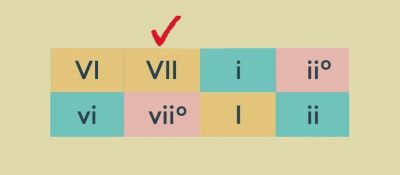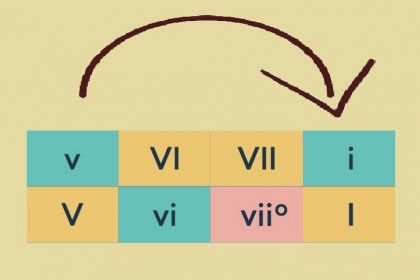Music Theory
Subtonic and leading-tone in cadences

Roman numerals indicating chords of minor and major scales
Musical Mode: Harmonic Minor Scale
Depending on the interval sequences of a particular diatonic scale, the seventh scale degree can be called subtonic or leading-tone. Subtonic refers to the whole-tone distance between the seventh scale degree and the first scale degree, known as the tonic, while the term leading-tone is used for the seventh degree positioned a semitone below the tonic. Strictly speaking, the leading tone can refer to any note which resolves to a note a semitone higher or lower but more often than not the term implies the seventh degree of several diatonic scales.
Of the seven diatonic scales forming the basis of their respective modes, the leading-tone is present in the major and Lydian modes, while the subtonic is found in the natural minor, Dorian, Phrygian, Mixolydian, and Locrian modes.
The seventh degree is an important element of the dominant function being a part of all three dominant family chords built on the third, fifth, and seventh degrees. Following the principles of harmonic analysis, chords are usually denoted by Roman numerals with capitalized numbers used for major chords and lowercase numbers reserved for minor chords. Thus, subtonic and leading-tone chords rooted in the seventh scale degrees can be designated as VII, vii, and vii0 for a diminished chord.
The leading tone is the most essential when applied as a resolution to the tonic in chord progressions V–I, known as a perfect authentic cadence. In this chord progression, the leading tone heightens listener expectations, alluding to the eventual resolution of the sequence via the tonic chord. In this case, only the major and Lydian modes allow for the strongest musical cadences. For this very purpose, the natural minor mode sees a semitone rise in the subtonic and the resulting switch to the dominant chord of the fifth degree, turning the minor into major. A scale such as this is called the harmonic minor scale and is usually found in progressions V–i, often performed in the final cadences of a piece or its sections.
Since subtonic scale degrees gravitate to tonic scale degrees that are considerably weaker than their leading-tone counterparts, the subtonic quite naturally resolves to the sixth scale degree when performed in the following progressions: VII–VI, III–iv, and III-VI. This feature finds its application in the Andalusian cadence or in other turnarounds designed to harmonize the melody in its descending stepwise movement from the tonic to the fifth scale degree. In addition to its melodic use, this descending move can often appear in bass lines or one of the inner voices, and can be harmonized conveniently with chord progressions i–III–VI–V, i–VII–VI–V, i–III–iv–V.
The triads rooted in the seventh scale degree are widely used in the diatonic scales where the triads are minor or major. If the vii0 chord is diminished, as is observed in the major mode, then its use should be preferably restricted to seventh chords and their inversions. It is noteworthy that the second inversion of the vii0 seventh сhord clearly expresses the subdominant function due to its structural similarity to the main subdominant family chord rooted in the fourth scale degree. This property is what causes the chord to appear in plagal cadences.



